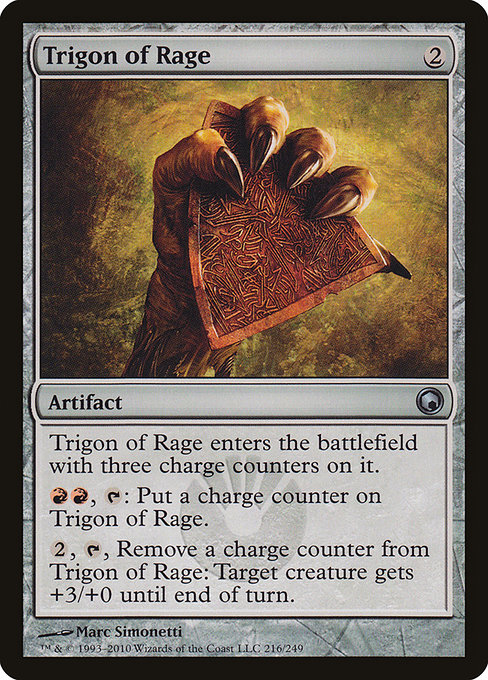
Image courtesy of Scryfall.com
When to unleash the Trigon of Rage: timing and tempo in red artifacts
There’s a mischievous charm to a modest two-mana artifact that wants to punch above its weight class. Trigon of Rage is that kind of card: a small, sturdy engine built on charge counters and a couple of punchy activated abilities. Entering the battlefield with three counters, this red artifact is a textbook example of how tempo and late-game inevitability can coexist in a single artifact frame. Its existence in Scars of Mirrodin captures that era’s love affair with colorless tools that still wear a red heart 🧙♂️🔥. The card’s simplicity—two mana to add a counter, two more to unleash a temporary +3/+0—offers a surprising range of moments you can turn into wins, especially when you’re racing against time and life totals alike 💎⚔️.
From a strategic standpoint, the bigger question isn’t “Can I make Trigon hit hard?” but “When is it best to press the trigger?” The answer depends on your board state, your cleanup steps, and how your opponent plans to answer a sudden pump. The Trigon’s three initial counters give you a built-in cushion for early aggression or a platform for a midgame blitz. You’re not just counting mana costs; you’re counting potential turns of pressure. In a world where red decks thrive on quick, decisive blows, the Trigon is a little engine that could—if you time your activations with care 🧙♂️🎲.
Early pressure and counter-tacing the board
On a typical turn 2 or turn 3, you can start stacking charge counters by paying {R}{R} to add one more counter. With your artifact already on the battlefield thanks to its three starting counters, that means your clock starts ticking from the moment you untap. If you’re up against a creature-heavy opponent, you can choose to boost a key attacker during combat or after blockers are declared, turning a modest 2/2 into a menace that simply won’t quit. The value is in forcing your opponent to respect a potential turn where a single activation weeks through for the win. The trick is to time the removal to catch them flat-footed—do it when their blockers aren’t in the right place, or when a single +3/+0 flip can push you into lethal range 💥.
Midgame swing: stacking the counters for a bigger finish
As the game unfolds, the Trigon’s counters become a resource you manage across several turns. If you’ve managed to maintain board presence while adding counters, you can sequence activations to maximize impact. For instance, remove a counter to pump a crucial attacker for a final push in combat, then use a later turn to repeat the trick with another creature or the same one if you’ve still got counters to spare. The beauty is that every activation is a fresh surprise—your opponent may preoccupied with your pace and miss the precise moment you drop the clutch buff. This is red’s calling card: making a single well-timed play feel like a decisive swing, even when the board isn’t full of megatanks or sweepers 🧙♂️🔥.
“A tiny furnace of rage, humming with molten red energy, ready to roar at the moment the moment calls for it.” — flavor text mood, Mirran engineering
Late-game, tempo preservation, and the art of the tempo trap
In longer games, the Trigon still shines, especially when you’ve built a board that can threaten lethal damage on a single swing. You don’t need a million counters to win; you just need to pick the right window. By removing counters for short, decisive boosts, you can ensure your best attacker breaks through a stalemate or pushes through a final two or three points of damage. The reliability of +3/+0 for a turn makes it a potent surprise tool in red artifacts lists, which often rely on pressure and bluff to tilt the game in your favor. Pair it with a haste enabler or a one-turn setup to surprise an unsuspecting opponent—after all, red loves a good mic drop 🔥⚔️.
Deck-building notes: where Trigon fits in
Trigon of Rage slots neatly into artifact or red-leaning archetypes that don’t mind a little mischief around the mana rocks. It’s legal in Modern and Legacy, and it’s a nice pickup for Commander tables where colorless tools can shine in a splashy red strategy. The card’s watermark, mirran, hints at a world where iron and fire fuse into relentless momentum—perfect for a deck that wants to pressure early and finish with a few well-timed boosts. The art by Marc Simonetti captures the molten intensity of a weaponized mechanism, a perfect visual companion to the card’s practical, punchy gameplay 🎨💎.
Trigon of Rage also serves as a gentle reminder of how artifact-oriented design can harness color to create memorable, satisfying turns. It’s not about overwhelming the board with a single spell; it’s about creating a rhythm—the beat of a red tempo plan that uses a compact artifact as its metronome. The card’s two-mana cost to surface, three counters on entry, and two-part activation pattern invites you to experiment with timing, creature choices, and attack sequencing. And when you finally untap with a couple of extra counters, you’re not just swinging for a line of damage—you’re delivering a moment of inevitability 🧙♂️🎲.
For fans and collectors, the Trigon of Rage sits in an interesting space: not as a flashy mythic, but as a functional, flavorful tool that embodies the era's love for practical artifacts with a twist. The rarity is uncommon, so it’s approachable for set collectors and casual players alike, while its combat-ready stability makes it genuinely useful in older formats—and surprisingly adaptable in newer ones where red artifact synergy remains a constant thrill ⚔️.
Phone Case Glossy Polycarbonate High Detail for iPhoneMore from our network
- https://blog.digital-vault.xyz/blog/post/curse-of-fools-wisdom-performance-across-deck-archetypes/
- https://blog.digital-vault.xyz/blog/post/common-thorn-mammoth-misplays-and-how-to-correct-them/
- https://crypto-acolytes.xyz/blog/post/ultimate-guide-to-minecraft-guns-mods-and-weapons/
- https://blog.digital-vault.xyz/blog/post/murky-sewer-symbolism-hidden-clues-in-mtg-card-art/
- https://crypto-acolytes.xyz/blog/post/outer-worlds-vs-fallout-new-vegas-which-rpg-reigns-supreme/